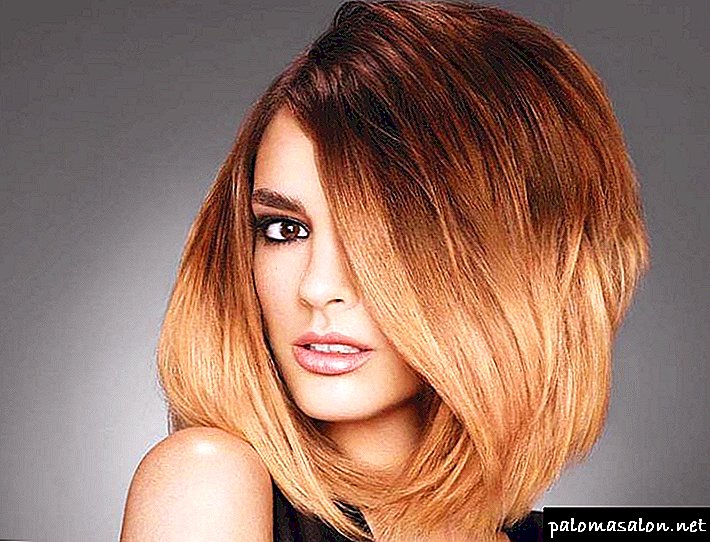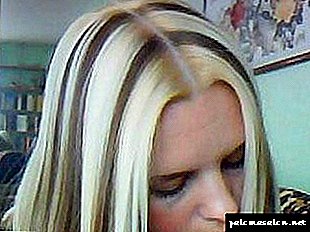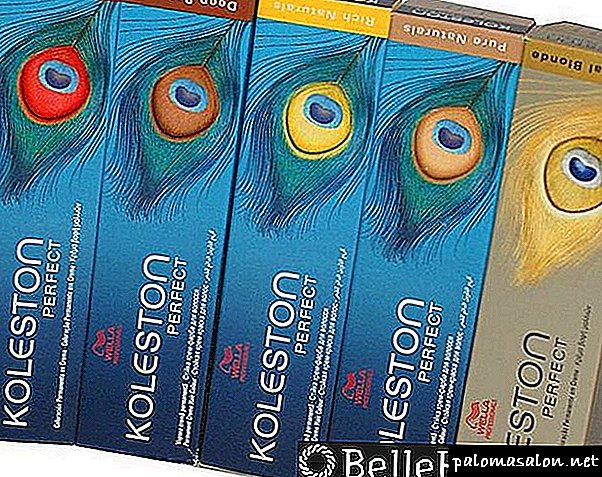Many girls dream that at any time of the year the strands look natural, shiny and bright. Some for this make highlighting, toning hair, lighten curls in the salon or at home. However, not everyone knows that there is a special procedure for coloring the order that allows them to become lighter, and you can do it yourself. A technology called shatush dyeing at home can help make hair bleached, shimmering in the sun, light or bright.

The essence of the technique of shatush, its features
Shatush dyeing is a special technology for lightening dark or blond hair, a bit like highlighting. After it, the strands look very impressive, slightly casually, and as natural as possible. The coloring composition is applied not on the foil or through a rubber cap, but directly along the entire length, starting approximately from the middle of the curls. Numerous photos of stars in fashion magazines constantly show girls with such chic hairstyles.

Features and advantages of shatush technology:
- curls look natural, sun-bleached, elegant and beautiful,
- at the roots, the hair remains its shade, then it becomes lighter, especially at the ends,
- if the highlight of the shatush is complemented by a strong tan, it creates the impression of relaxing at the seaside resort,
- hair looks more voluminous due to the smooth transition of shades,
- when staining the roots are not damaged, because they are not affected by the applied composition,
- You can slightly or visibly lighten dark strands, add brightness, overflows to them,
- strands of different tones hide the flaws of the face, draw attention to the merits, emphasize the beautiful oval.
In the photo you can see examples of fashionable now highlighting the ends in order to choose the most suitable option for yourself. This technique is simple, even at home without problems you can achieve this result by studying the video instructions and the steps of the technique.


What is the technique of shatush
Shatush technique is a unique innovation that radically changed the concept of traditional painting. In this case, the color change occurs with some distance from the hair roots. Pigment is applied to thin strands. In this case, light shades are often used. The ends of the hair have the brightest tone. A stunning effect can be obtained by using several shades from the same color palette.
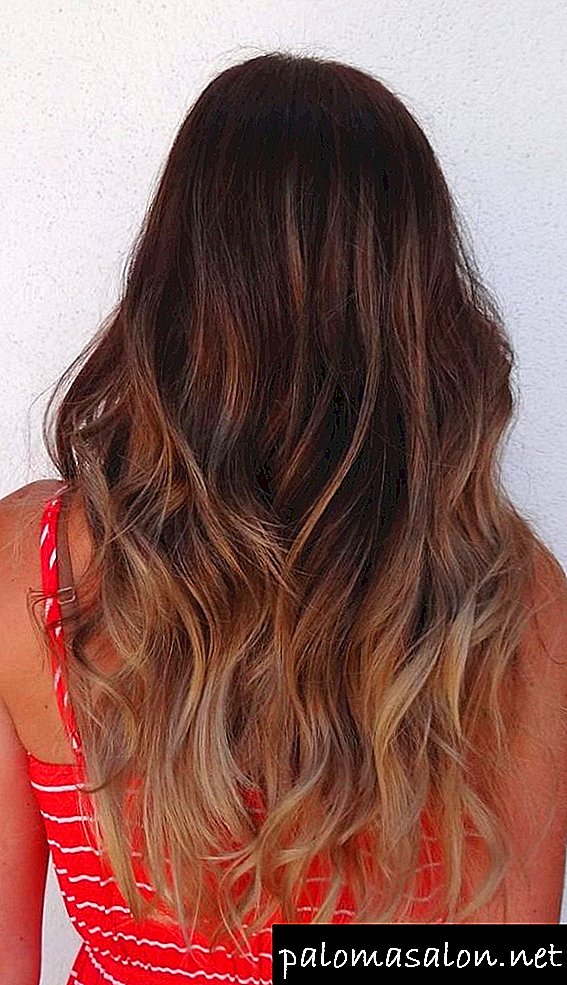
Shatush technique - coloring, implying a smooth clarification
The difference between the techniques of shatush, balayazh and ombre
Shatush is differently called French highlighting. It has its fundamental differences from similar staining techniques. In this case, the change in hair color is not more than half of their length. Due to the smooth transition one gets the impression of strands of different but barely perceptible shades fading into the sun.
Technique balayazh has some similarities with shatush, but performed differently. Lightening occurs almost at the very tips. The specialist applies paint only superficially, sweeping movements. The border between the tones is also blurred. But in contrast to the previous method, it is assumed uniform coloring without the game of glare.
When hair color changes with the help of the ombra technique, a transition from dark to light tone, starting from the roots and ending with the tips, occurs. Pigments are selected from a palette of natural shades. In this case, the roots often remain either in the original color or are darkened. The border between tones is sometimes very clear, unlike the previous techniques.
The advantages of shatush technology
Many women prefer the technique of shatush for the reason that after the staining creates a natural image. A smooth transition of colors and the effect of burning hair in the sun is achieved. Since natural make-up and hair color are in fashion, the shatush technique meets the latest trends. In addition, as a result of the procedure, the curls will play with different shades in the light, which cannot be achieved when staining with one tone.
In addition, the shatush does not require frequent correction, since the change of tone is carried out from the middle of the hair length. Overgrown curls will not be evident, as with standard staining.
Who is suitable shatush?
It is believed that shatush hair coloring technique is best suited for brunettes and brown-haired women with dark skin. At the same time, even on dark hair, a sharp transition will not be noticeable. After all, the change of tones is carried out gradually. The brightest shades focus on the tips, which creates an extraordinary impression of the image.
This effect is difficult to achieve blondes. To do this, they will have to lighten the strands too much, which ultimately will negatively affect the condition of the hair. Shatush on gray hair is performed mainly with a preliminary alignment of tone. This technique is not recommended for girls with too pale skin.
Preparation for coloring
Before you start coloring, you should prepare the hair. For this, it is not recommended to wash your hair first. However, to choose the most suitable option, you need to first make a haircut. Best of all, the shatush looks on long hair, so it is not recommended to shorten the curls too much. Due to the presence of long strands, you can create a multi-level transition effect and the game of glare, which will make the image natural and bright at the same time.
Coloring technique in the cabin
This coloring technique implies a double approach: with and without a pile. The first method is as follows:
- Hair must be properly combed. All strands need to be separated from each other. Each of them should be no more than 2 cm in thickness.
- With one hand, a separate curl is taken and scored with quick movements from the bottom up. Then the composition is applied with light strokes. Coloring is carried out only in the place of a pile.
- Top does not impose foil or any other material to enhance the effect. Coloring occurs in air for 10–30 minutes. The exposure time depends on how strongly it is necessary to lighten the strands.
- Each individual curl is applied its tinting composition.
- Then the specialist washes away the paint and styles the hair with the help of a hair dryer.
This method is more often used for medium and short strands.
Short hair shading coloring - video
Another technology, in which not carried, is as follows:
- First of all, a specialist selects a range that could show a smooth transition and was close in tone to natural hair.
- Paint is applied with a thin brush or fingers. Manipulation requires high professionalism. At the same time, the specialist takes small strands and applies the composition with soft, but fast movements.
- Exposure time from 10 minutes to half an hour. After that, the coloring composition is washed off and styled with a hair dryer and other devices. However, immediately after dyeing, it is not recommended to use a curling iron.
The second method of painting on the technique of shatush can be performed only by an experienced master. This approach is applicable mainly to long hair. Self-resort to this technique is not recommended.
Coloring at home
Self-staining using this technique is a very difficult task, because getting the same result as in the cabin will be problematic. However, if you follow the basic rules, you can achieve a good effect. First of all, you need to decide on the range of shades.
Basic rules for color matching:
- For light brown hair should choose light shades. If the hair is short, then two is enough. For long strands, you can choose three similar in tone options. From copper-blond to bright blonde.
- For brown hair, it is better to give preference to copper-golden shades, smoothly turning into light brown and light blond. A combination of such tones on a long head of hair will look especially advantageous. For short hair is better to use 2 shades close to the natural color, but a little lighter.
- For burning brunette with long hair is recommended to choose from 4 to 5 shades. In this case, the transition should be gradual. Starting from the middle of the hair, it is recommended to use brown and copper flowers, closer to the ends you need to gradually lighten the strands. Care should be taken with short hair. It is better to use chestnut pigment, which does not create a sharp transition effect.
For dyeing gray hair, you can use shades of light brown and dark blonde. Self tinted strands in this case is not recommended.
The coloring technique is as follows:
- It is necessary to make a high tail, which should be located somewhere in the middle of the head.
- Split the strands of 1.5 cm. Then comb all the hair, which are collected in a bun, until the elastic.
- Prepare several glass bowls with selected shades.
- Then apply the paint with light strokes. Special attention should be paid to the tips. There the composition should be the most.
- At home, painted strands are best wrapped in polyethylene, as the compositions for self-use are not as concentrated as in the cabin. After half an hour, you can wash off the paint and wash your hair in the usual way.
What it is?
In general, such options have long been known. After all, shatush is a variation on the subject of highlighting. The only difference is that with this method they select shades that have a slight difference in color. And the border between them should not be clear, but very smooth, natural. For staining used fine strands, taken in a chaotic manner. The result will be not only natural looking hair, but also additional volume.
In what situations is it worth resorting to shatush painting? It fits almost all women. The only exception is the owners of short hair, since on such a hairstyle this highlighting will look extremely unnatural.
If you want to change something in the image, but there is no desire to drastically change the color, if you want to grow the "native" shade, if you need to even out the tone after the previous dyeing, if you also need volume to the natural hair, if you can not often visit the hairdresser, You have dark hair - these are exactly the situations when shatush coloring is the best way out. The technology is more suitable for owners of dark hair, but also blondes will find options for themselves. In addition, it is worth considering that this method is not very suitable for painting gray hair.
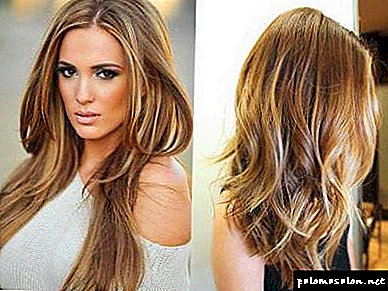
Between themselves, two techniques are very similar: ombra and shatush. The difference between them is that shatush assumes natural colors, while in the ombre technique completely opposite shades and eccentric colors can be used.
Now various technologies of coloring are fashionable - brondirovanie, shatush, ombra, California or Venetian highlighting. However, all these methods converge in the main thing - naturalness. Today it is the main requirement for appearance, be it a hairstyle or clothes. The contrived, overly deliberate in our day is not in fashion.
It is possible to do shatusha both on natural hair, and on already existing highlighting. In addition, experts use such dyes that cause minimum damage to the hair. The absence of additional warming through the use of foil or caps also leads to minimization of the damage caused.
Shatush with a pile
The classic way - shatush with pile. First of all, the hair is divided into strands up to 2.5 cm wide. Each of them is panty at the roots. A clarifier is applied to the remaining mass. The main thing at this stage of shatush dyeing is the choice of the percentage of oxidizer. For weak and thin hair, it should be as small as possible. For thick and very dark hair, the oxidizer should be no less than 12%.

After holding the oxidizer, it is necessary to thoroughly wash it off. After that, the main toning agent is applied.
The tool is applied with a brush so that it spreads through the hair. If at the end the result is not too noticeable, you can further correct it by toning.
Shatush without pile
An experienced hairdresser applies the color so that there is no need to comb hair. This is done as follows.
Dyes are selected so that there is not much difference between shades - otherwise it will look very rough. From the roots indentation of several centimeters is made. The paint is applied with chaotic strokes, without a clear border. The time that the paint remains on the hair, the master chooses individually, based on the structure of the strands, the initial color and the desired shade.
Shatush house
At first glance it seems that this is a very simple method, therefore it is quite capable of making shatush at home. Coloring instructions, however, require experience, knowledge and a solid hand. It is very difficult to create a truly natural hairstyle at home, so it’s better to turn to a professional. If this is not possible, but to have hair no worse than that of a star, you want to, you should carefully study the step-by-step video. In addition, you need to strictly adhere to all recommendations.

Can I dye my hair at home myself?
Shatush is a rather complicated technique for beginners in coloring and it will not be easy to achieve a harmonious beautiful result. However, not every girl can afford a trip to the salon because of the high prices for this technique, and therefore many of them prefer to carry out the dyeing themselves.
By itself, shatush does not require any special knowledge. The main thing is to strictly follow all the instructions and then you can achieve a good result without spending a lot of money.
What is needed for the procedure?
For this procedure, you will need the following:
- Paint and brightener.
- Special brush and container for paint.
- Comb to create a pile.
- Towel.
- Gloves.
- Cape
- Shampoo and balm.
How to prepare the hair?
In order that coloring in house conditions was not worse, than in professional salons, hair needs to be prepared. A few days before the procedure, it is desirable to feed them with special masks corresponding to the type of hair.
It is also recommended to trim the tips a couple of days before painting and give them the shape that will look best with the shatush technique. To save curls and reduce the risk of damage from the use of chemical dye product paint should be applied to dirty hair. Thus, the last shampooing before the procedure should be 2-3 days. During this period it is not advisable to use any styling products.
With fleece: step by step instructions
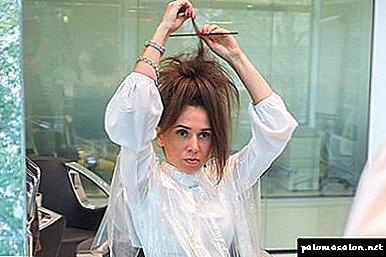 Hair should be carefully combed and collected in a high tail. The closer the tail is from the forehead line, the more noticeable the result will be. In order for the effect to be only on the tips, the tail must be collected closer to the crown.
Hair should be carefully combed and collected in a high tail. The closer the tail is from the forehead line, the more noticeable the result will be. In order for the effect to be only on the tips, the tail must be collected closer to the crown.- Carefully separating the strands, you need to hold on each of them with a comb, to create a pile. This stage is the key, since further result and contrast depend on the density and density of the pile.
- The next step is paint preparation. It is necessary to mix the paint with an oxidizing agent in a special pottery made of ceramic or plastic, and then mix thoroughly until smooth.The amount of paint is taken on the basis of the length and thickness of the strands. On average hair, long to the blades, it may well be enough for one package of paint.
- Using a brush, paint should be applied to the combed strands with careless and even careless strokes. The less evenly the paint will be distributed through the hair, the brighter and more beautiful the result will be. After the strands are colored, they must be twisted into a braid and left for 20-25 minutes.
Useful tips
In order not to spoil the curls when applying paint with your own hands, you should take into account a few useful tips:
- Apply dye exclusively on dry hair.
- Hair is best washed a few days before painting.
- Pick paint and oxidizer based on the natural color of the strands.
How to care for curls after the procedure?
 Usually, It is required to update the color after painting with the Shatush technique not earlier than in 2-3 months. All this time, the hair needs to be properly maintained, otherwise the color may fade quickly. Also, care will help curls cope with the recent effects of the dye, which very often leads to dryness and damage to the hair.
Usually, It is required to update the color after painting with the Shatush technique not earlier than in 2-3 months. All this time, the hair needs to be properly maintained, otherwise the color may fade quickly. Also, care will help curls cope with the recent effects of the dye, which very often leads to dryness and damage to the hair.
Proper hair care after dyeing consists of:
- Use of shampoos and balms suitable for hair type.
- Careful and accurate combing.
- The use of special moisturizing and nourishing masks.
- Full failure for the first time from thermal tools intended for installation.
What if the result was not achieved?
In rare cases, the result may not be what was expected. In such situations, first of all, it is necessary to pay attention to the paint and oxidant that was used for dyeing. The paint itself may be expired or the dye was not strong enough.
You can also correct this situation yourself, but since the curls have just been painted and the new exposure to chemicals can spoil them, it is advisable to wait 2-3 weeks. If the hair needs to be tidied up as quickly as possible, then It is better to contact a specialist who can correct the result without harm to the hair.
The difference between shatush and similar techniques of highlighting
Hair coloring is a responsible matter. Sometimes in the cabin you can get the opposite of the expected result. Shatush is in essence a highlighting, which even inexperienced masters often confuse with other similar techniques:

However, this type of coloring has characteristic features. Unlike traditional highlighting, the lightening compound is applied not from the roots, but significantly lower. No caps, foil wrapping required, reduced exposure time.
Brondirovanie creates strands of several shades, but without a smooth transition. The entire length is evenly colored, the hairstyle takes on the appearance of a soft rainbow. Shatush implies a subtle change in tonality, the use of one color, the intensity increasing from top to bottom. 
Balayazh is a transverse, superficial clarification. Paint is applied in light strokes, without affecting the inner layers. This is the main similarity of the two techniques. The difference is that balayazh gives a more uniform color with a blurred, but tangible border color change. 
Ombre feature - full coloring tips on the entire volume of hair. The difference with the roots can be from 2 to 8 tones; both natural and non-standard shades are used - blue, red, eggplant. Although the transitions are shaded, it's hard not to notice them. 
As a result, such a picture emerges. Shatush hair is very different from the ombra, highlighting, brondirovaniya, has a similarity with the weight and looks like this:
- randomly selected strands,
- more light on the face, less on the back of the head,
- smooth transitions of one tone,
- staining about half the length
- in the hair only natural shades, close to the main color.
The hair looks voluminous, in combination with tanned skin, evokes thoughts of a recent vacation, refreshes the face, hides light defects. Coloring is suitable for any age, allows you to liven up your own color, make gray hair imperceptible. The only obstacle may be too short haircut. 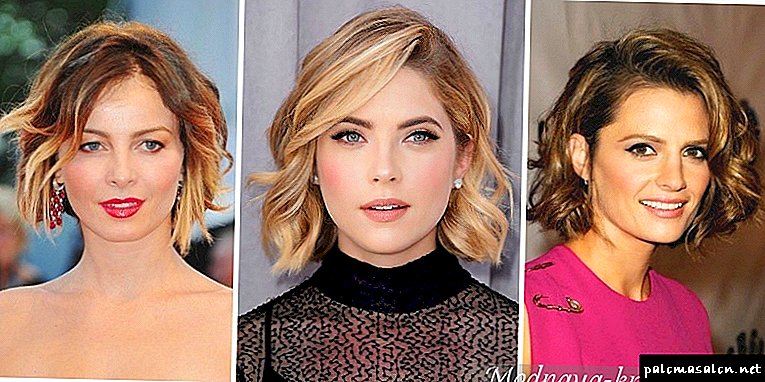
You need to prepare in advance:
- Any suitable clarifier or highlighting kit. Well proven drugs such as Estel "De Luxe Ultra Blond", Palette Deluxe, Wella "Safira Highlighting".
- The desired shade of tinting paint.
- Wooden comb, dishes for mixing drugs, brush, gloves.

The procedure at home includes the following simple steps:
- Creating a pile over the entire head at the roots. It is recommended to do it from the neck, moving to the crown and temples. It is necessary to comb thin strands no more than 2 centimeters thick, retreating from the roots about 10 cm. After such combing, the head should resemble a fluffy dandelion.
- Preparation of the composition for home lighting. It is necessary to breed the clarifier according to the instruction which is available in packing, having put gloves on hands.
- Lightening pryadok. To do this, the paint should be applied with a special brush on the combed strands, moving from the top of the head to the ends. The last thing you need to paint over whiskey. The composition should be kept from 15 to 40 minutes depending on the initial color of the curls.
- Flushing paint, drying pryadok.
- Toning hair suitable shade to give naturalness and naturalness.

Properly done highlighting shatush will allow you to achieve the same result as in the photo. On dark hair, the effect will be more noticeable, but light will become even brighter and more expressive.
Tips and tricks for beginners when coloring
In order for the coloring of the shatush to be spectacular, beautiful and natural even at home, you should follow some of the recommendations of specialists:
- in no case it is not necessary to treat the roots with paint, it is necessary to deviate from them approximately 10-15 cm depending on the length of the hair,
- smooth color transitions are achieved through combing, so it should be done very carefully,
- there should be no styling products on the hair before the procedure, it is advisable to pre-cut or cut the split ends,
- paint must be applied from top to bottom with soft stretching movements in order to achieve smooth color transitions,
- a couple of weeks before lightening it is advisable to start making moisturizing and nourishing masks to restore the health of the curls,
- for highlighting strands, it is recommended to use such brightening shades as ashy, wheat, pearl, golden, beige.

Photo-examples of dyeing on light and dark strands indicate its effectiveness, but this procedure is suitable only for owners of medium and long hair. For those who have short strands, it is recommended to make a real highlight on the foil of an experienced master.

Video instructions with detailed explanations will help to fully understand all the steps, learn this simple technology.
Precautions and care for dyed hair
If the coloring according to the Shatush technique occurred without preliminary toning, then correction is often not necessary. It is enough to refresh the color once every 2-3 months. If the hair has been preliminarily brightened or, on the contrary, has been dyed in a darker shade, then it is recommended to make a correction once a month, since the regrown roots will look careless.
If the hair is too thick, then preference should be given only salon painting. At home, it is very difficult to use the shatush technique on a voluminous and long hair.
In addition to the main recommendations, you should protect dyed hair from the aggressive effects of styling products. It should not be too often to use curling iron and other thermal devices for straightening and curling. Dyed hair should be washed with special shampoos that preserve the brightness of the tone. It is recommended to make nutritional masks once a week to prevent the hair sectioning. You can use the usual sea buckthorn oil. To do this, just lubricate the tips and leave the tool for half an hour. Then rinse thoroughly.
Reviews of shatush coloring technique
I decided on a shatushka absolutely spontaneously, before that I thought about whether the game was worth the candle, because staining for this technique costs from 3.5 to 7 thousand rubles. on hair of medium length. But, here in one of the groups in social networks I saw that one school is prestigious in my city (where not amateurs come, but acting masters for advanced training and development of new techniques) are looking for models that pay only the cost of the material. I gave only 1.5 thousand rubles .. this is the cost of paint, it should be noted that the painting took place on the paint Loreal and Vella Prof., which is also quite good. My wishes were such, I had at my tips a part of blond-clad locks, a good part of my hair had time to grow, my source is 7 tons of blond hair. I wanted a more natural transition between blond and straightened strands, I did not strive to become blonde blonde. I advise girls who appreciate natural and natural images, the times of the snowy cold blond are over. The initial condition of the hair should be at least more or less normal, whatever one may say, shatush is coloring, I advise you not to injure too damaged hair, it is better to restore the condition of hair, and then think about coloring. Agree on dead hair, any staining will not look.
black brilliant
I am 23 years old, and until now I have adhered to the rule - “do not dye your hair, otherwise they will deteriorate”. Now I have another rule - the hair is not the hands, grow back. Tired of natural honey blond hair color. I wanted something brighter, but I was afraid to take risks and do something cardinal. You can't hide your hair from the eyes of society, you want to look adequate, you like yourself first. And so, I came to the salon, saying to the hairdresser (I went not to my master, whom I visited about 8 years old, but to a new girl of yesterday's student, notes to the salon, which always, without changing), that I want highlighting. Of course, while I showed her the picture where the desired result was captured. I am glad that the girl, though a young master, but dissuaded me from "highlighting." She offered me a technique that adds brightness, the very "raisins", and there will not be these stripes "chipmunk", there will be no contrast between the roots and the rest of the hair. In the end, I was pleased.
Anastasia.fenasty
A very fashionable a few years ago, the highlighting of hair retreated and it became relevant in a new dyeing format whose name the shatush technique is a French dyeing technique. When dyeing, the hairdresser retreats a fairly decent distance from the roots of the hair and in some way blends out the brightening dye over the hair, then tints the individual strands. The hair strands are not painted over the entire length of the hair web, which, accordingly, is pleasant, since it preserves not only the root zone of the hair from damage. In this sense, even mothers of schoolgirls are not against such a sparing method of coloring their young daughters according to the technology of shatush. It looks very beautiful and spectacular. It is not necessary to dye growing roots every month as with ordinary dyeing or highlighting; it is enough to maintain such beauty once every 3 months.
Svelena
Modern technology of coloring shatush is practical, fashionable and convenient. There is no need to constantly paint the roots, thanks to the smooth transition of colors and a rich palette of colors. Of course, not everyone can do shatush professionally, so it’s best to trust experienced specialists. If the hair is thin, then you can try and self-dyeing.
Features of technology
 In fact, shatush is a modernized highlighting. Strands are lightened at a certain distance at the roots with a uniform distribution along the head of hair. But the shatush looks much softer, remotely resembling the effect of natural hair burning. In this technique, there is no sharp boundary between the base and lighter colors.
In fact, shatush is a modernized highlighting. Strands are lightened at a certain distance at the roots with a uniform distribution along the head of hair. But the shatush looks much softer, remotely resembling the effect of natural hair burning. In this technique, there is no sharp boundary between the base and lighter colors.
The secret lies in the way the paint is applied, allowing uneven staining of the strand. Partially shatush has something in common with ombre and balayazhem. But in ombra there is a clear horizontal transition from dark to light. And in balayaazh though there are no sharp boundaries, but the ends are intensely bleached and create a bright array.
Shatush strives for maximum naturalness. Ideally, the work of the master should be almost invisible. But in recent years, color toning has come into vogue with bright colors: red, blue, green. In the correct shatush they gradually interlace, and do not fall contrasting spots.
Advantages and disadvantages
Shatush is much more popular than classic highlighting, because it has a lot of advantages:
- looks very natural,
- minimally damages hair
- very refreshing face and whole image,
 perfectly hides the early gray hair,
perfectly hides the early gray hair,- visually increases volume
- suitable for any length and shape
- does not require frequent correction
- does not damage the hair root and scalp,
- performed on dark and blond hair.
But if you make the shatush wrong, the burned-through strands turn yellow and look very ugly. In addition, to achieve a smooth transition on your own is difficult, this requires the skill of stretching paint, which is acquired with experience.
Experts do not recommend experimenting at home on long hair. But on medium and short you can try.
Preparatory stage
Before you do shatush at home hair should be prepared. It is believed that lightening less damage the hair if done on a dirty head. But on the stuck together greasy hair the paint falls worse and it is difficult to work with them. Do not wash your hair is a maximum of a day, with very dry hair - two.
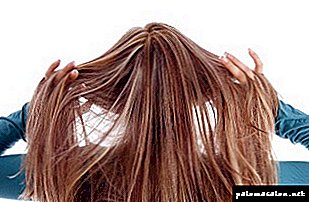 Dyed in a very dark color or naturally black hair will have to be pretreated with a wash, otherwise a yellow or a dirty gray shade will turn out.
Dyed in a very dark color or naturally black hair will have to be pretreated with a wash, otherwise a yellow or a dirty gray shade will turn out.
Burning brunettes do shatush not recommended. But if you really really want, then it's better to go to the salon to a good hairdresser.
If you plan to use additional colors or tonic, they must be selected in advance, taking into account your own color type and taste preferences. It is necessary to prepare and all the accessories that may be needed in the process. You will have to work quickly so that the strands are lightened evenly, so there will simply not be time to search for the missing tools.
Choice of shades
Even if you do shatush only using a brightener, there is no guarantee that you will not need additional toning. When self-bleaching brown and dark hair, they often acquire an ugly yellow shade, which is desirable to neutralize or disguise tint.
If the hair is long, you can create soft horizontal transitions using 2-3 shades stretched vertically.
In the short, it is better to take only one additional color with a difference of 2-3 tones from the base. Hair on the shoulder can be dyed in any way - everything looks beautiful on them.
The choice of color professional hairdressers give the following recommendations:
 Blonde should not be further clarified - the effect will still not be noticeable much. It is better to choose reverse shatush and slightly darken the ends in nutty, milk chocolate, light copper and other shades.
Blonde should not be further clarified - the effect will still not be noticeable much. It is better to choose reverse shatush and slightly darken the ends in nutty, milk chocolate, light copper and other shades.- Dark blonde when lightening often goes into yellowness and requires additional toning in silver or ashy shades. For the reverse shatusha, you can take any shades of brown.
- Ginger natural tone best highlighted reddish colors: copper, strawberry, ripe cherry.When lightening it may turn sunny yellow, but it often looks beautiful.
- Brown hair is a warm gamut. They fit wheat, gold, nut shades. But often it is enough just to lighten them for a couple of tones.
Color toning looks beautiful on black and dark brown hair. But it is quickly washed out. Therefore, deciding on the color shatush, remember that it will have to be tinted at least once a week, otherwise the curls will look faded.
Performance technique
The easiest in the home version is the technique of shatush with a pile. It is suitable for short smooth haircuts (for example, bob) and medium hair length. The coloring scheme looks like this:
- the hair is carefully combed and divided into zones
- in the back of the head, a small strand is isolated and slightly combed over the entire length,
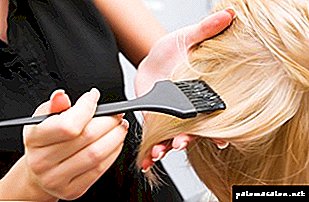 lightly applied paint or brightening composition,
lightly applied paint or brightening composition,- repeat the procedure throughout the head evenly distributing strands,
- maintain the time specified in the instructions
- thoroughly wash off the brightening compound,
- blot with a towel and lightly dry with a hairdryer,
- gently unravel the combed strands,
- if necessary, tinted hair,
- thoroughly wash out the tonic and apply a reducing balm,
- after 3-5 minutes, the head is again washed, dried and laid.
Important! The paint is applied with light vertical strokes using a plastic brush. In this case, it is necessary to ensure that it does not tear the combed strands.
Often in the video you can see the shatush, as done with your fingers. This technique of applying paint is used for very curly or very long hair. But it requires great skill to lay the color evenly and in a thin layer. Therefore, at home it should not be used - only high-level professionals work this way.
Frequent mistakes
Qualitatively making yourself shatush is not so simple. On a short hairstyle, it often looks like a not-cut coloring, especially if the clarifier is applied too far from the roots.
On medium and long hair, the most common errors are:
- burn-through strands are obtained by using too strong an oxidizing agent, disrupting the technology of dyeing or exceeding the exposure time of the composition,
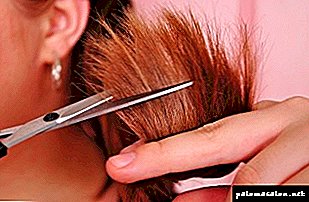 yellow tint - its appearance on the hair causes many reasons, and it is easy to get rid of it with the help of a silvery tint balm,
yellow tint - its appearance on the hair causes many reasons, and it is easy to get rid of it with the help of a silvery tint balm,- sharp border of color transition - it turns out, if you forget to comb strands or apply paint too thick, you can fix it with a tonic close to the natural color or repeated staining,
- uneven distribution of strands - also often turns out at home, you have to go to the master, so that he paints over the missing sections,
- the wrong shade turned out - poor-quality paint was used, or the hair had previously been dyed with henna or basma, only a professional can make the correction.
Trying to fix serious mistakes at home is not worth it. If you didn’t manage to do well painting in the style of shatush the first time, then a second session can only worsen the situation, and then the only way out is a short haircut.
Home care
Amateur always works slower than a professional. So, when dyeing the hair is damaged more.
But even if you did everything right, resistant paints partially destroy the protective layer and need to be restored with nourishing masks. They should be done at least twice a week.
Do not neglect other rules of care for hair:
 use soft, high-quality shampoos,
use soft, high-quality shampoos,- minimize thermosetting
- do not dry your hair with hot air,
- Do not comb wet hair,
- use a spray with a UV filter,
- apply special oils on the tips,
- Do not collect hair in tight tails and braids.
Shatush does not require frequent adjustments - it is quite enough to correct it once every 2-3 months. If there is a lot of gray hair, you will have to tint the roots as they grow. A good tonic does not harm the hair, so it is used as needed.
According to most women, if you adapt yourself, then doing shatush at home for medium hair is easy enough. But on short and long mistakes are made more often and they are more noticeable. So in this case it is better to trust the professionals and do the painting in the cabin.
The basic principles of this hair dye technique
Shatush technique is inherently similar to Ombre and Balayaz. The strands are partially lightened or tinted a couple of colors lighter than your main color, thanks to which natural and refined effect is created sun-bleached hair.
And it turns out the most smooth transition of color from the lighter tips of the hair to the roots, which are not affected by coloring.
You can see the difference between the techniques of shatush, ombre and balazezh in this picture.
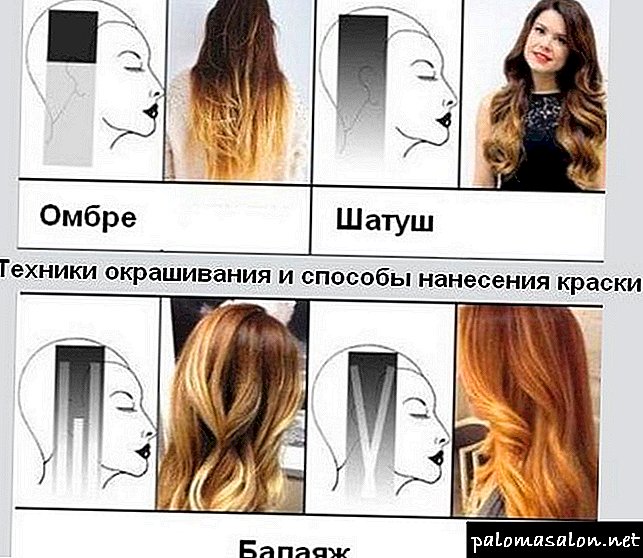
Varieties and types
The most impressive and beautiful this technique looks on long hair and curls of medium length. For a short haircut, it is still better to choose balayazh or ombre.
Photo painting long dark hair on the technique of shatush

Photo coloring shatush on the hair caret
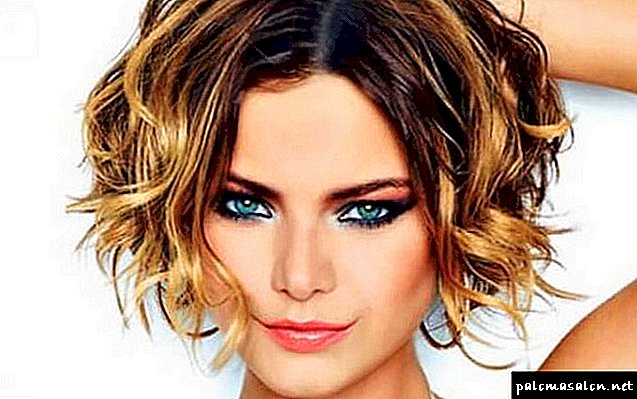
Shatush coloring on red hair

How to make shatush staining at home - detailed instructions with step by step photos
If you have experience of self-dyeing or highlighting, you can try to make shatush at home.
For the first time, we suggest that you make a simpler version of a shatush — hair tail from the tail.
You will need:
- a brightener or hair dye that is lighter than your color for a couple of tones,
- paint dilution tank
- hairdresser paint brush,
- a pair of gloves,
- comb with frequent teeth for combing,
- regular comb,
- hairpin or hair clips (if you still decide to divide your hair into several zones),
- polyethylene cape so as not to stain clothes.
Scheme and technology of staining by the method of shatush.
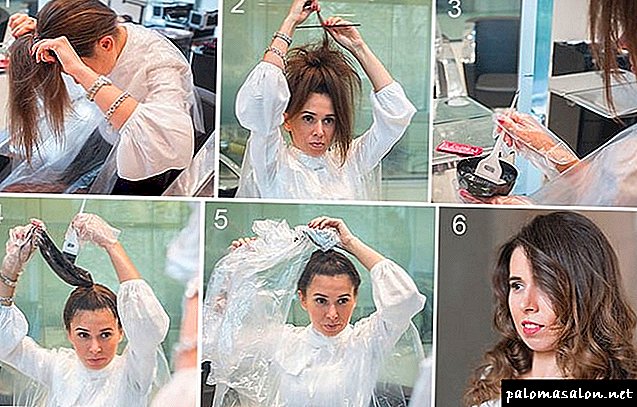
When it is justified to do it at home, and in which it is better to go to the salon
Of course, the final decision is yours, but you can still try do shatush independently if:
- You are well versed in the technology of staining or highlighting,
- you want to change your image a little, without resorting to radical measures,
- you have medium or long hair of dark blonde, ashen and other similar shades, which you can immediately shatush without applying additional toning.

But in some cases you can not do without the salon:
- you are not sure about your own capabilities or do not want to spend extra time and effort
- you liked a particular shade or a few,
- you have blond or red hair that needs correction before the procedure - toning, trimming, etc.
- Your hair has kept the remnants of the previous coloring.
Angelina, 30 years old:
From time to time I began to notice treacherous gray hairs in my hair, so now I permanently dye my eyes. Recently I decided to try the shatush hair dyeing technique at home in order to revitalize the hair color a little.
No problems arose, because I already practiced painting and highlighting. I divided my hair into four parts, combed it out, put a beige shade on it for half an hour, washed it off.
It turned out not bad, but in a month, I’ll probably go to the hairdresser. Let them try to make me shatush with two or three shades.
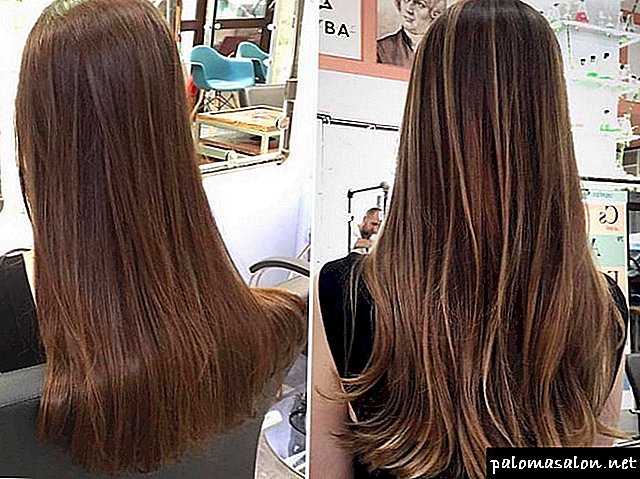
Photos before and after dyeing hair by the method of shatush.
Svetlana, 29 years old:
I made an ombra about three months ago, but now I wanted something new. I do not want to repaint, so as not to injure my hair once again. Therefore, I stopped at the method of shatush. In addition, I was very interested in how to do the dyeing on the pile.
She worked with only one paint - brightener, kept on her hair for half an hour. As a result, the transition of shades turned out not quite the same as I expected, but overall I am satisfied.
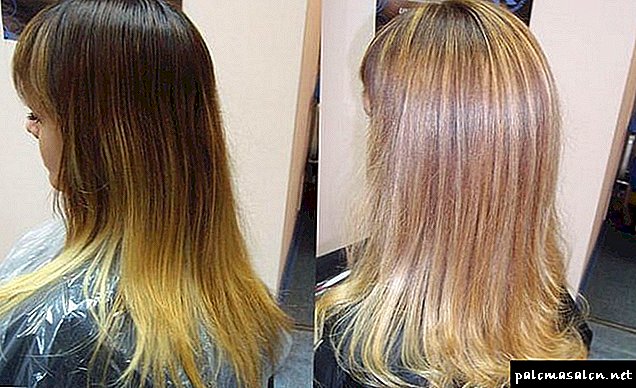
Photos before and after dyeing hair in the style of shatush.
Otherwise, when performing shatush, the old shade may be inharmoniously mixed with the new one, and you will not get the result you expected.
Victoria, 33 years:
I have always been a supporter of naturalness and naturalness. Within reasonable limits, of course. Therefore, techniques like shatush just for my taste. I didn’t want many shades, so I made shatush at home in the simplest possible way.
I combed a ponytail, treated it with a light brush on the back of the hair and held the paint for about twenty minutes. It turned out like a bit burnt strands - this is exactly the effect I was trying to achieve. In general, I am quite pleased. And colleagues said that I looked younger.
But now I doubt - can I make a mask out of colorless henna? I read about its benefits and want to try, but I don’t know if it is possible to do shatush after painting.

Photos before and after applying staining shatush.
The basic concept of highlighting shatush
Shatush coloring style is quite different from the classical principles of highlighting. The technique is based on a special color stretching along the entire hairline. One of the creative aspects of shatush was repaint hair without the use of special foil or hats for highlighting. The hair areas prepared for dyeing remain completely open during the whole procedure, which makes the result a very natural and fascinating depth of each individual shade.

In the work of the master usually focuses on a maximum of 3-4 tonal solutions, as close as possible to a single palette. The technique of shatush does not imply aggressive bleaching of the strands, coloring agents most often belong to the group of ammonia-free ones, which delicately penetrate into the structure of each hair. The most popular and beloved in the hairdressing world of the world are the dyes of the following brands: Matrix Color Synk cream color palette, Londa Professional, Wella Professionals Color Touch, Goldwell Colorance, Ollin Intense Color. In the final stages of highlighting shatush the master must select the optimal tinting shades that will guarantee smoothness and the absence of borders between the color layers. The modern line of toning shades is very variable. For example, brown-haired women and brunettes can transfer golden, wheat, nut, beige, and also pearl and ashy tones to their strands. The result of the work of the hairdresser should be the effect of burning the strands under the rays of the sun, which has some similarity with light clarification.
Before the procedure of dyeing using the Shatush technique, it is necessary to achieve a uniform hair color over the entire length, so if necessary, the whole mass of hair should be dyed in one tone, which will become the base color.
What distinguishes the technique of highlighting shatush from other types of hair dye? Features of shatush will help answer this question:
- the use of delicate dyes, gently affecting hair pigmentation,
- dyeing is carried out without the use of foil, in the open air,
- For softer and more uniform color transitions, a pile is formed on the hair before dyeing, and the dyeing composition itself is distributed along the strands with a certain indentation from the roots,
- Shatush technique is more suitable for medium and long hair, as short haircuts will not be able to fully imagine the depth of all color transformations,
- The strands selected for dyeing should be as thin as possible for a more natural look.




What are the advantages and disadvantages of Shatush technology?
The advantages of highlighting in the style of shatush:
- the curls change color under the influence of benign coloring agents on a non-ammonia base,
- the speed of the coloring procedure, which basically amounts to 40-50 minutes of the master's work,
- the technique allows at the same time to achieve several effects: additional volume, the effect of strands uniformly burnt from the sun's rays, a beautiful emphasis on the relief of the overall haircut (which is especially important for cascading, multi-level haircuts),
- the ability to control the intensity of the effect of paint. Shatush refers to the "open" type of staining, and therefore the master can observe the whole process of color transformation and wash the tool immediately after reaching the planned result,
- a large interval between procedures for about (3 months) saves not only time but also money. Hair regrowth will not look too obvious or untidy,
- shatush coloring can be an effective tool for masking graying strands,
- the lack of clear boundaries between the transformation of the dark color of the roots in the clarified tips,
- creation of unique in its depth and tint gamut of color highlights. The hairstyle will be equally spectacular in both natural and artificial light.

Especially significant shortcomings in the technique of shatush have not yet been revealed, the only negative point was the restriction on the length of the hair - for girls with short haircuts, this kind of highlighting is not suitable.
Shatush coloring is definitely not a way of self-expression for owners of blond shades or colors close to them, red-haired beauties also fall into this category.


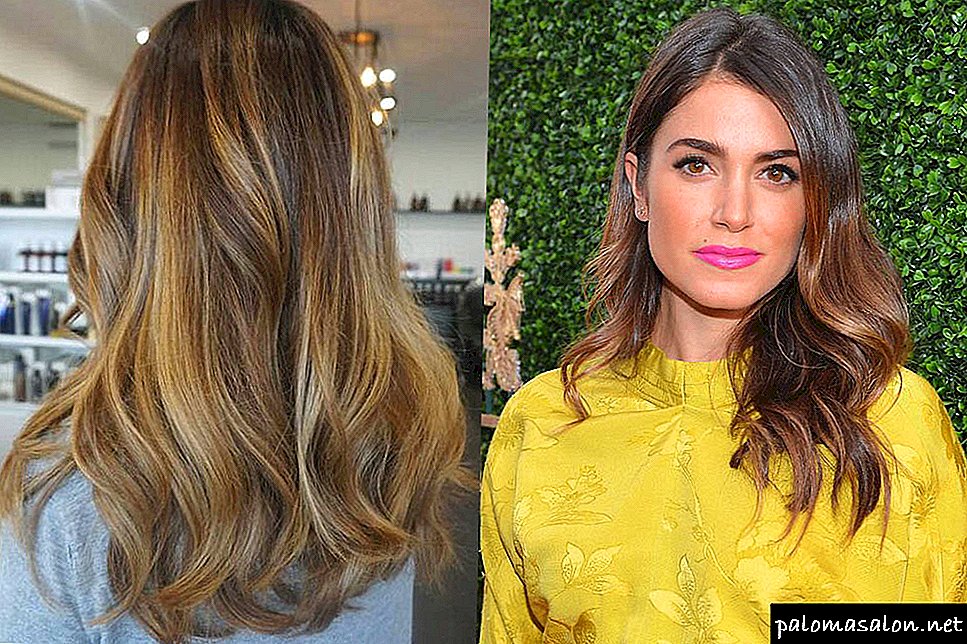

How is the shatush technique implemented in practice?
Shatush-style hair dyeing technology is quite complex, which is confirmed by the definitely high price category of this service. Therefore, it will be problematic and in some sense even risky to implement shatush coloring at home. Only a competent and professional approach will be able to bring the perfect result to your hair.

Hairdressing arsenal for the implementation of the highlight technology shatush:
- Professional paint (3-4 shades close to each other),
- Brush for applying dye composition, comb-comb and some fix hairpins,
- Special capacity for the preparation of paint.
At present, there are 2 techniques of dyeing shatush - with the formation of brushes on the curls and without brushes. Consider the specifics of these methods separately.
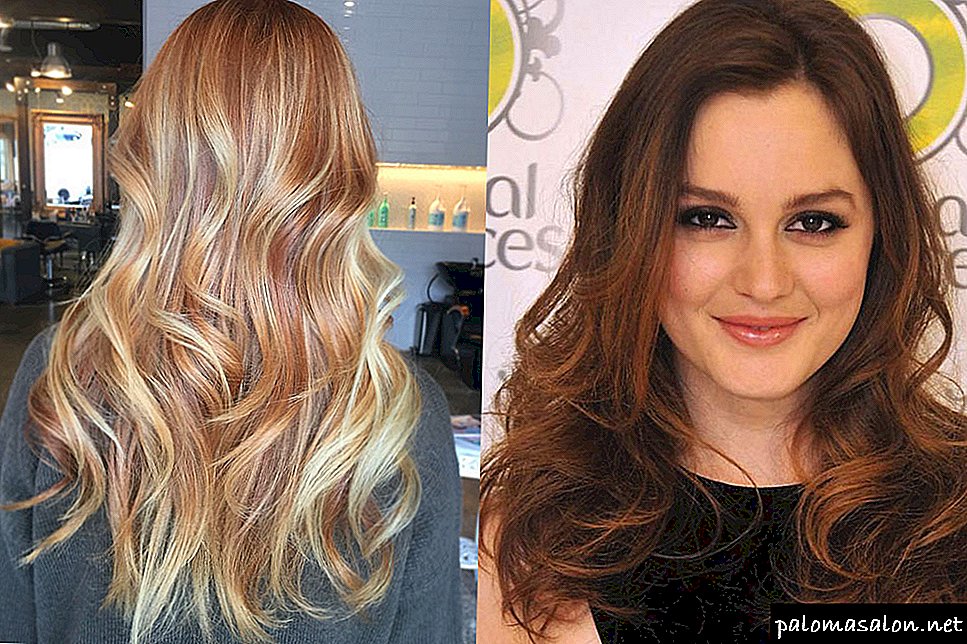
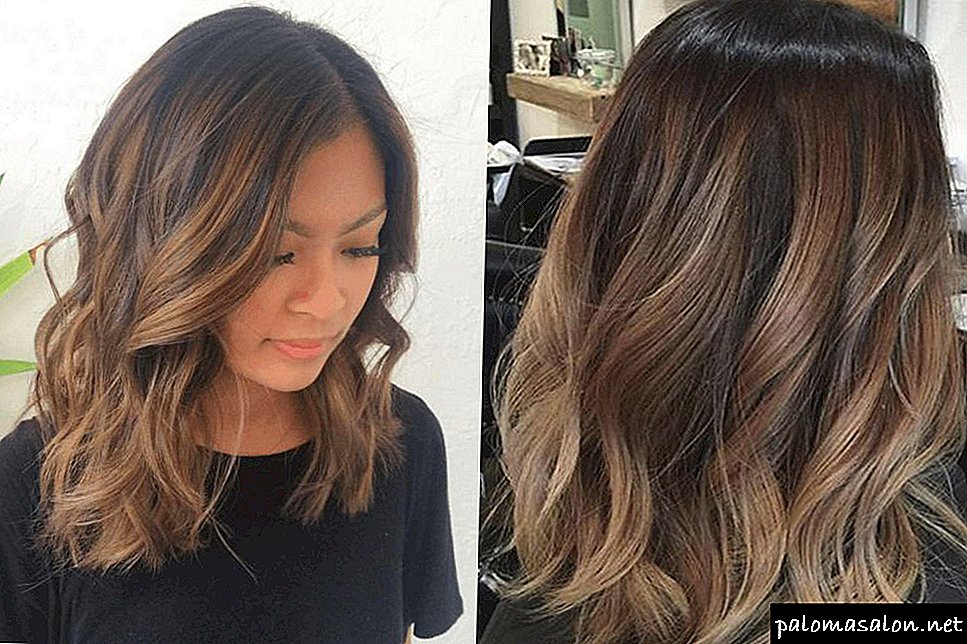


The beauty of technology shatush on dark hair
Hair of dark shades - just perfect for coloring shatush. It is against a dark background that color stretch marks look the most impressive and attractive. Dyeing shatush for black hair, brown, chocolate or dark copper shades - today is very popular in beauty salons. The longer the strands, the more advantageous the new image will look. There are no restrictions on age, skin tone or hair type here. The only "but" can be a category of short haircuts in the style of unisex, in other cases, cascading, multi-layered haircuts or square will be very preferable.

The choice of shatush shades for dark hair is quite tempting - it can be any natural shades of wheat, copper, red, gold, light brown and honey. In a special trend in hair coloring today there are brandy, chestnut, nutty and beige shades. But of all the variety of options, the master professional will not use more than 3 shades, most often it is just 2 tones, flowing into each other so smoothly that the color borders are completely blurred - this is exactly what the flawless execution of the shatush technique on dark hair should look like.
Hair of dark shades are exposed to dye for 40 to 45 minutes.


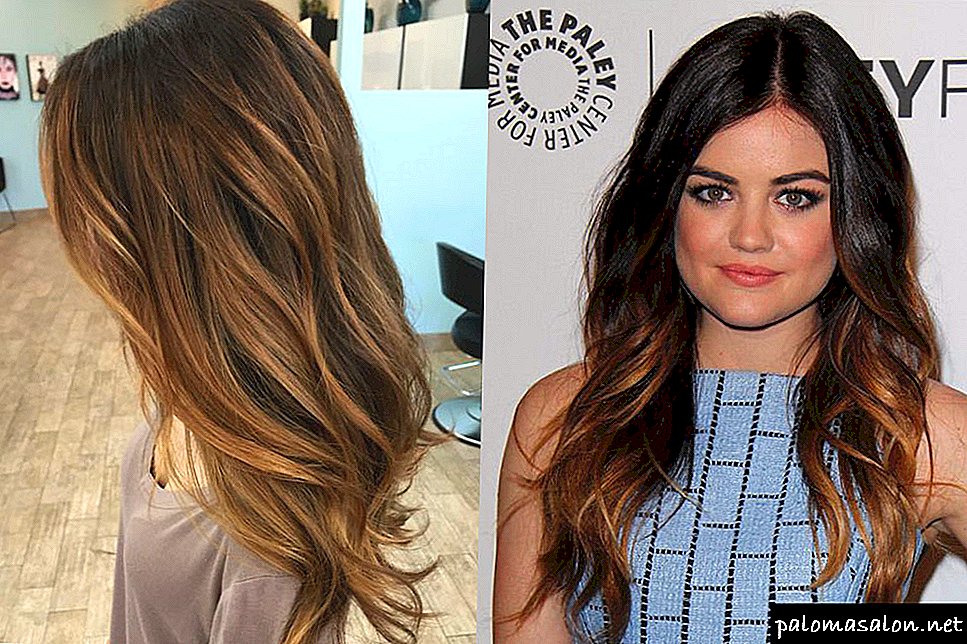
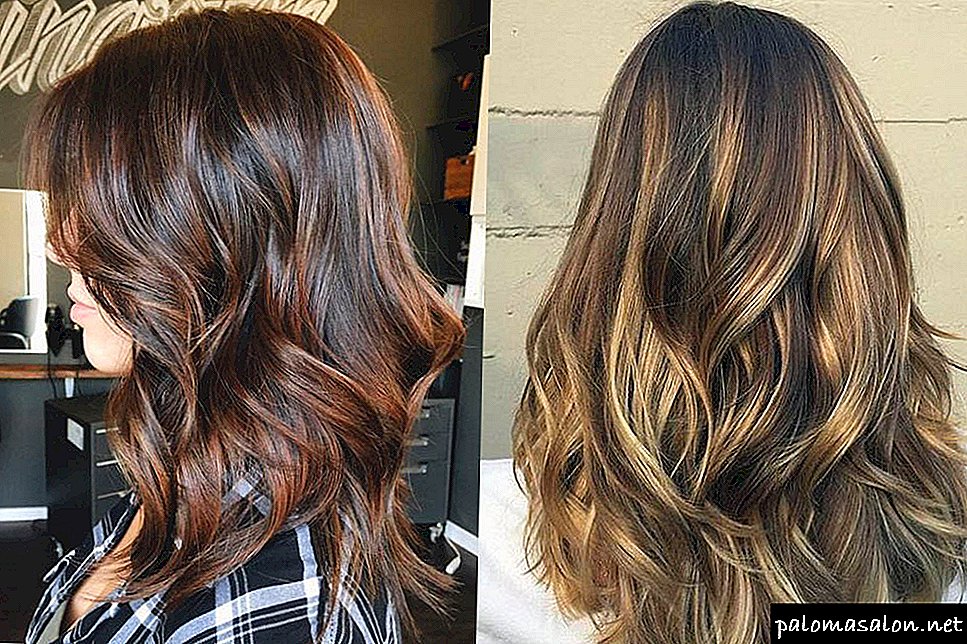
Technology shatush on light brown hair
With brown hair selection of color palette for shatush gives a great opportunity to breathe new breath into your image, as well as get closer to the style of the most trendy and famous fashionistas of the world. Shatush coloring is applicable to hair of light brown shade.
- updating the color highlights will create unique color accents at the depth of the original color of the hair,
- minimal damage to the health of the hair - in working with such hair apply dyes without ammonia,
- Shatush on light brown hair will rejuvenate and refresh the complexion of the girl.

The following variants have fallen into the shading range for shatushs on light brown hair: the color of wheat, gold, amber, ash, pearls, walnut and beige. The key condition for the correct choice of colors will be the client's color type. Cold shades of ash will begin to harmonize with the skin of a light tone, and dark skin will be decorated with warm shades of gold or wheat.
In order to make shatush at home on the girls' blond hair, they mostly turn to blond shades. To do this, you can purchase a special powder - a clarifier and four 3% oxides, which, due to their peculiarities, will eliminate the appearance of undesirable redhead, also you should not forget about tinting paint.
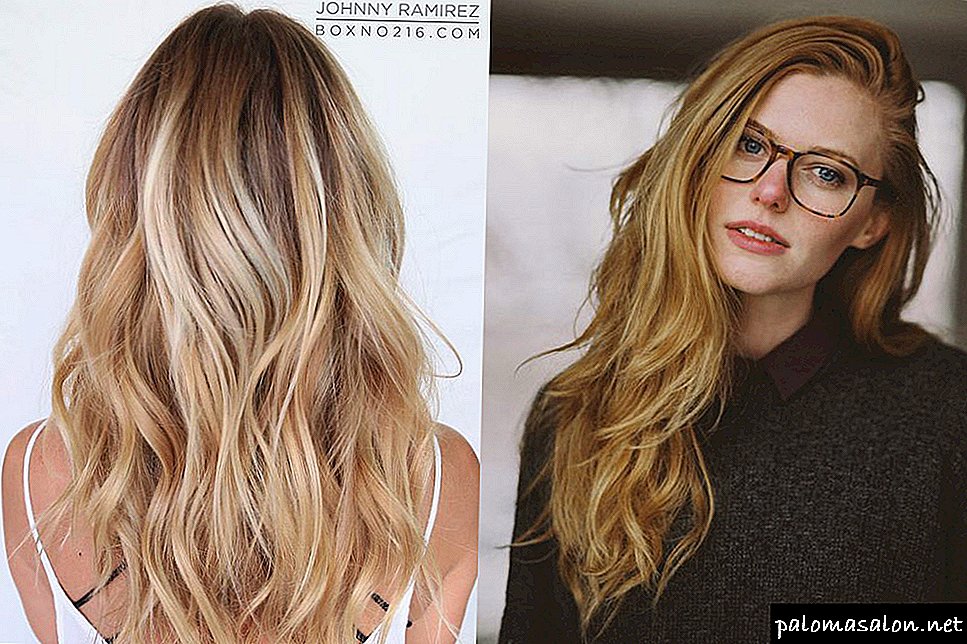



Highlighting shatush on blond hair
Shatush on blond hair is an excellent option to refresh the usual curls and make the curls to play in a new way by sunlight. This technique of "sun kiss" is very easy to implement on light strands, as their natural pigmentation easily and quickly turns into a different color shade. In working with such hair there is also no need to use aggressive dyes - a non-ammonia base is a great option.

Considering the fact that shatush is usually realized on light hair within 2-shading solutions, this type of highlighting will not be as clearly visible as on dark or light brown hair.
Girls with a warm, southern color type opt for warm, golden-beige tones, and their opposite - cold color, as usual, uses an ashy palette.




Extravagant Shatush version
Extraordinary and extravagant personalities were able to create a separate niche in the world of hair coloring, even in relation to the technique of shatush. The desire to stand out from the crowd pushes the girls to the most unpredictable and bold color metamorphosis of the hair. In shatush highlighting, this was manifested in the use of color solutions that are very far from natural shades, but with full observance of all shatush technology rules. Spectacular and creative beauties can appear before the views of others with a black root zone, which gradually turns into green, red, purple or other bright endings of strands.

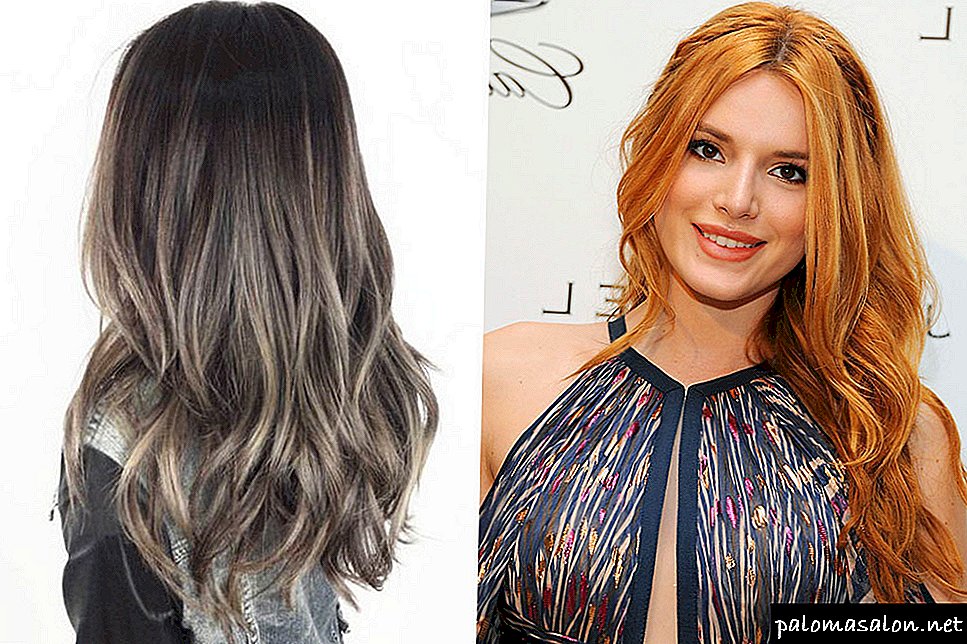

Hair after dyeing shatush or how to care for the strands after such a procedure?
The entire process of hair care must include not only the procedures after the actual coloring of the shatush, but also preparatory actions that minimize the degree of negative impact on the hair structure. Before going to the salon, you should make sure that there are no split, lifeless hairs on the hair, otherwise the strands will need some cleaning and therapeutic procedures. Masks with the effect of restoration and nutrition, as well as rinses, balms will not be out of place. As for the thermal load on the strands, it should be minimized a few weeks before the coloring procedure. Subsequent care after the transformation of hairstyles with the technique of shatush will be more careful and attention to all the details. You may have to change the shampoo and balm, which should have a direct purpose for the hair after highlighting. To restore and protect thin-type hair, prone to fragility, you need to purchase silicone-based products that will wrap each hair film. Special series of balsams and rinses can nourish the hair from the inside, greatly facilitating the process of combing and styling.
A separate category of hair care after shatush is made up by masks, which can be easily prepared by yourself from kefir, herbal infusions. And the most desirable components of home grooming masks will be egg yolk, honey, natural oils (olive, coconut, vegetable), sour cream, yeast. In the case of a lack of time, you can simply buy ready-made masks with similar miracle compositions in specialized stores. The effect will also be positive - restoration of lipid balance, protective function, healthy gloss and shine of curls, silky structure and fixing of new pigments.

The styling procedure should also be focused on a more vulnerable hair structure after the dyeing process, which should appear in:
- temporary refusal of styling thermal instruments - hair dryer, curling iron, thermal hair rollers or ironing,
- more rare use of fixatives - varnishes, foams and mousses, which are better replaced by reducing serums and sprays,
- ensuring protection of hair from direct sunlight, in particular in warm weather,
- careful and neat combing hair, gentle styling,
- temperature control during washing hair (water should be strictly warm, the most comfortable temperature).

 Hair should be carefully combed and collected in a high tail. The closer the tail is from the forehead line, the more noticeable the result will be. In order for the effect to be only on the tips, the tail must be collected closer to the crown.
Hair should be carefully combed and collected in a high tail. The closer the tail is from the forehead line, the more noticeable the result will be. In order for the effect to be only on the tips, the tail must be collected closer to the crown. perfectly hides the early gray hair,
perfectly hides the early gray hair, Blonde should not be further clarified - the effect will still not be noticeable much. It is better to choose reverse shatush and slightly darken the ends in nutty, milk chocolate, light copper and other shades.
Blonde should not be further clarified - the effect will still not be noticeable much. It is better to choose reverse shatush and slightly darken the ends in nutty, milk chocolate, light copper and other shades. lightly applied paint or brightening composition,
lightly applied paint or brightening composition, yellow tint - its appearance on the hair causes many reasons, and it is easy to get rid of it with the help of a silvery tint balm,
yellow tint - its appearance on the hair causes many reasons, and it is easy to get rid of it with the help of a silvery tint balm, use soft, high-quality shampoos,
use soft, high-quality shampoos,